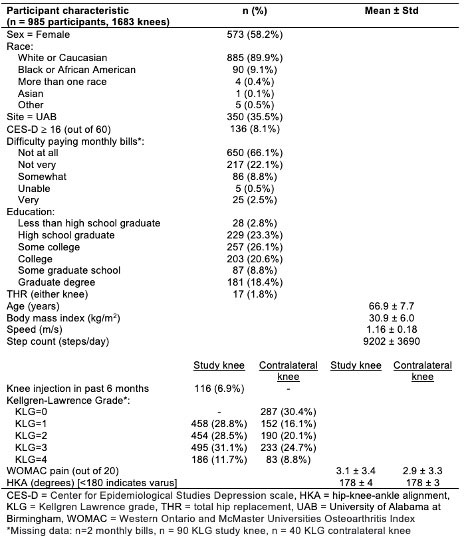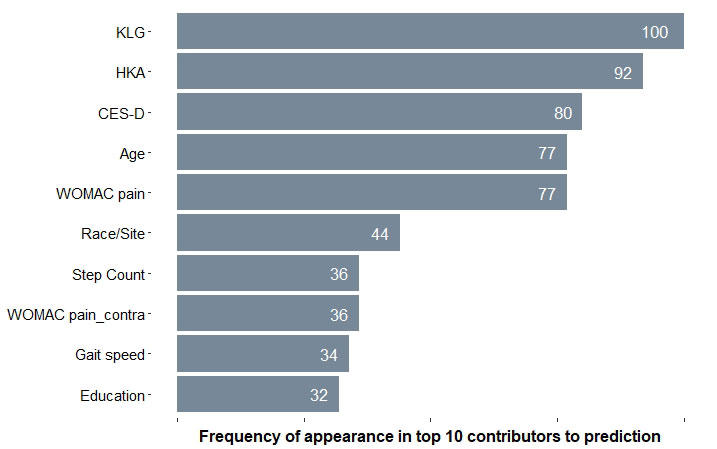Session Information
Session Type: Poster Session D
Session Time: 1:00PM-3:00PM
Background/Purpose: Rates of knee replacement (KR) due to knee osteoarthritis (OA) are rising exponentially and currently no interventions prevent KR. Gait and physical activity are potentially modifiable risk factors in people with knee OA and thus are of interest as potential treatment targets. Applying machine learning approaches to large datasets can help us understand the influence of interrelated gait and physical activity predictors on risk of KR. The objectives of this study were to 1) predict KR at 8-year follow-up using a machine learning model with gait and physical activity inputs, 2) identify influential predictors of KR from the model, and 3) quantify the effect of these predictors on KR using a causal inference approach.
Methods: Demographic and clinical data, spatiotemporal gait data from self-selected speed walking (GaitRite), and physical activity data from 7 days of accelerometer wear (StepWatch) were collected from participants with and at risk for knee OA at the 60-month visit of the Multicenter Osteoarthritis Study [MOST] (current study baseline). Knees without radiographic signs of structural damage (Kellgren Lawrence Grade [KLG] = 0) were excluded from analysis. The outcome was incidence of KR at 8-years after baseline. An ensemble machine learning approach was used to predict the outcome from 16 gait, 3 physical activity, and 15 demographic/clinical features at baseline. Data were randomly split 100 times for training and testing in the ratio 7:3, respectively. Model performance was evaluated on the held-out test sets using the area under the receiver operating characteristic curve (AUC). Influential predictors were defined as the 10 features most frequently appearing in the top 10 contributors to prediction (via a variable importance measure statistic). We used g-computation to estimate the marginal risk differences of these influential predictors on KR.
Results: Of 1683 knees, 229 (13.6%) underwent KR by 8-years (sample characteristics in Table 1). The median AUC (2.5th-97.5th percentile) across 100 data splits was 0.85 (0.80-0.88). Influential predictors identified by the model are shown in Figure 1. Marginal risk differences (and 95% confidence intervals) are shown in Figure 2 and can be interpreted as the difference in risk of KR per 100 knees in the given category compared to the referent category. Higher KLG, worse pain, and varus alignment were associated with higher risk of KR. CES-D ≥ 16 and self-identified Black race were associated with lower risk. No gait or physical activity measures had statistically significant effects on KR risk.
Conclusion: Our machine learning model that included gait and physical activity variables predicted KR with high AUC. While few gait and physical activity variables were identified as being influential, their relationship with risk of KR could not be confirmed. Higher risk of KR was identified for common risk factors for OA progression (KLG, pain, and alignment). Spatiotemporal gait parameters do not directly relate to knee joint loading and metrics such as knee moment and muscle activation may perform better. Unmeasured factors such as insurance and clinician or patient preferences also influence decisions to undergo KR and may explain our findings for CES-D and race.
To cite this abstract in AMA style:
Costello K, Felson D, Jafarzadeh S, Segal N, Lewis C, Nevitt M, Kolachalama V, Kumar D. Gait and Physical Activity Predictors of Knee Replacement: A Machine Learning Analysis in the Multicenter Osteoarthritis Study [abstract]. Arthritis Rheumatol. 2022; 74 (suppl 9). https://acrabstracts.org/abstract/gait-and-physical-activity-predictors-of-knee-replacement-a-machine-learning-analysis-in-the-multicenter-osteoarthritis-study/. Accessed .« Back to ACR Convergence 2022
ACR Meeting Abstracts - https://acrabstracts.org/abstract/gait-and-physical-activity-predictors-of-knee-replacement-a-machine-learning-analysis-in-the-multicenter-osteoarthritis-study/



